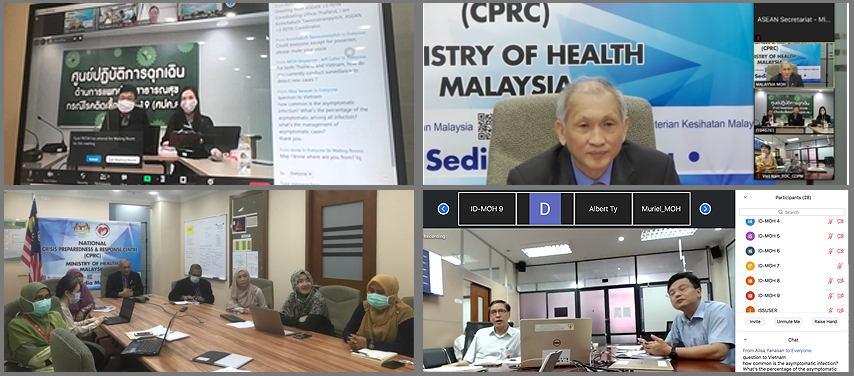ASEAN Health Experts share government policies in tackling COVID-19 pandemic
May 19, 2020
KUALA LUMPUR, 19 May 2020 – The ASEAN Emergency Operations Centre Network for Public Health Emergencies (ASEAN EOC Network) hosted another video conference among ASEAN Member States (AMS) health officials focusing on major government policies for containment, mitigation, and recovery phases in addressing the COVID-19 pandemic.
Officials from Thailand and Viet Nam described the implementation of policies, strategies and measures taken by the government in all phases in their response to COVID-19. They also discussed the potential challenges and concerns as they move on to the next phase of their response.
Thailand, the first country to report COVID-19 cases outside of China, has a total of 3,031 confirmed cases and 56 deaths. The country experienced a sharp surge of cases in March and April, and has reported less than 10 new cases per day since 5 May.
Incident Commander for Department of Disease Control of Thailand’s Ministry of Public Health Dr. Sopon Lamsirithaworn shared that in addition to the public health response measures in January, Thailand implemented unprecedented community quarantine (lockdown) measures in early April following the declaration of a state of emergency by the Prime Minister in late March.
In an effort to stop the spread of the virus, all schools were temporarily closed, mass gatherings and non-vital business transactions prohibited, international flights banned, movement of people across provinces restricted, and a curfew between 11.00pm to 4.00am was imposed. Lamsirithaworn also discussed Thailand’s screening and hotel quarantining strategies.
Meanwhile Viet Nam, with a total of 324 confirmed cases, has not reported any COVID-19 related deaths since the start of the outbreak and has not detected new cases in community in the last 32 days.
Director General of Viet Nam’s Health Ministry’s General Department of Preventive Medicine Dr. Dang Quang Tan mentioned that Viet Nam activated its response system since early January due to concerns over limited resources, high population density and long borders with outbreak countries.
The country established multi-sectoral committees at all levels, and rolled out a national response using a whole-of-society approach guided by the four-point strategy of prevention, early detection and ring-fencing to delay community transmission, treatment of all confirmed cases, and sustained and continuous risk communication.
Dang added that Viet Nam also imposed temporary restrictions for domestic and international flights, enhanced surveillance by expanding the suspect case definition and conducting massive contact tracing, and underscored the importance of community participation as well as strong government engagement.
At the video conference, participants discussed the discharge criteria for positive COVID-19 patients and measures to address re-positives, screening/testing methods including management of asymptomatic, surveillance and control measures in communities, and the reopening of communities and relaxing of lock down measures in AMS.
Lamsirithaworn mentioned that Thailand started to re-open businesses through a phased approach since 3 May. The approach is guided by a classification through type of businesses that will reopen at a specific period and follows a restricted time and standard set by the government. Meanwhile, Viet Nam has prepared for a long-term mitigation plan at the national level for COVID-19 transmission.
The video conference was also attended by focal points from the ASEAN Plus Three Field Epidemiology Training Network (ASEAN+3 FETN). It concluded with a renewed commitment by members of the ASEAN EOC Network and the ASEAN+3 FETN to continue and strengthen information exchanges and relevant updates, and lessons learnt on COVID19 response.
Related Articles
- Statement of The Special ASEAN 3+ Health Ministers Meeting on Severe Acute Respiratory Syndrome (SARS) “ASEAN is a SARS Free Region”
- The Thirty Second Meeting of the ASEAN Minsters on Agriculture and Forestry (32nd AMAF) Phnom Penh, 23 October 2010
- Joint Statement of ASEAN Plus Three Health Ministers Gathered Together for the Special Meeting on Ebola Preparedness and Response, Bangkok, Thailand, 15 December 2014
- Joint Statement of ASEAN Plus Three Health Ministers’ Special VDO Conference on the Threat of MERS-COV in the Region
- Joint Statement of the 7th ASEAN Plus Three Health Ministers Meeting
